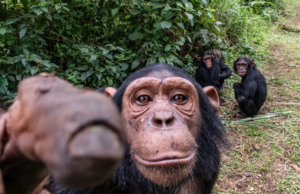Humans aren’t the only great apes that can ‘read minds’

By Virginia Morell (Science AAAS)
All great mind reading begins with chocolate. That’s the basis for a classic experiment that tests whether children have something called theory of mind—the ability to attribute desires, intentions, and knowledge to others. When they see someone hide a chocolate bar in a box, then leave the room while a second person sneaks in and hides it elsewhere, they have to guess where the first person will look for the bar. If they guess “in the original box,” they pass the test, and show they understand what’s going on in the first person’s mind—even when it doesn’t match reality.
For years, only humans were thought to have this key cognitive skill of attributing “false belief,” which is believed to underlie deception, empathy, teaching, and perhaps even language. But three species of great apes—chimpanzees, bonobos, and orangutans—also know when someone holds a false belief, according to a new study published today in Science. The groundbreaking study suggests that this skill likely can be traced back to the last common ancestor of great apes and humans, and may be found in other species.
“Testing the idea that nonhuman [animals] can have minds has been the Rubicon that skeptics have again and again said no nonhuman has ever, or will ever, cross,” says Brian Hare, an evolutionary anthropologist at Duke University in Durham, North Carolina, who was not involved in the study. “Well, back to the drawing board!”
For nearly 40 years, animal cognition researchers have had mixed results in showing that our close ape relatives—and animals such as monkeys, jays, and crows—understood that their fellows had minds, a talent thought to come in handy in complex societies, where figuring out another’s plans can help animals thrive. Some tests have shown that chimpanzees had some building blocks of theory of mind: They can deceive, recognize others’ motives, and remember who is a good partner on collaborative tasks. They can also tell what another chimp can and cannot see, and they can reason about the movement of objects they themselves can’t directly see. But they—and other primates—had not been shown to hold false belief.
To get around this impasse, the scientists behind the new study turned to soap operas and high-tech eye-tracking technology. Like many of us, great apes love a good drama, says Christopher Krupenye, an evolutionary anthropologist also at Duke who co-led the study with Fumihiro Kano of Kyoto University in Japan. “When there’s confrontation between individuals, they’re curious about what will happen next,” he says, as evidenced by their widened eyes. So the scientists filmed a colleague dressed as a generic apelike figure, nicknamed King Kong, who steals a rock from a man, hides the rock in one of two boxes, and then scares the man away. While he’s gone, Kong hides the stone in the other box, but then changes his mind and carries it out of sight. What does the man do when he returns? Most of us would predict that he’ll search for the rock in the first box, where it was when he left the scene.
To find out whether great apes think this, too, the scientists screened their movie to 14 chimpanzees, nine bonobos, and seven orangutans. Through an infrared eye-tracker, the researchers measured what the animals were watching throughout the film. When the man returned, 22 of the 30 animals looked directly at the boxes, with 17 staring at the first box, where Kong initially hid the rock. Their eye movements, the scientists say, show that these apes correctly guessed the man would open the box where he’d last seen the rock—even though the apes knew it was no longer there. The researchers got similar results from having 40 apes view another, slightly different, film.
Unlike previous false-belief tests for great apes, this one doesn’t involve food, which has the unintended consequence of also testing their self-control, Krupenye says. “In our test, they only have to remember something that just happened; they aren’t weighed down by other cognitive demands.” The eye-tracking method also avoids using language, an unavoidable element of many theories of mind tests, says Frans de Waal, a primatologist at Emory University in Atlanta who was not involved in the study, but who wrote an accompanying perspective in Science.
“It’s a very surprising and novel finding,” says Victoria Southgate, a developmental psychologist at the University of London, who helped create the eye-tracking technique to test 2-year-old infants and was not involved in this research. “It’s an almost exact replication of the study we did, and the apes appear to pass. It suggests that the capacity to track others’ perspectives and beliefs is not unique to humans.”
But Laurie Santos, a cognitive psychologist at Yale University who has shown that rhesus macaques lack an understanding of false belief, thinks the “paper raises more questions than it provides answers,” especially because there have been “so many past results showing that chimpanzees and other primates lack this capacity.”
Krupenye says he and his colleagues have more work to do before they can definitively conclude that apes understand false beliefs. “We’ve shown that they can predict others’ behaviors, which is a sophisticated ability,” and one not previously demonstrated. He and his colleagues say they now need to devise a behavioral scenario where the apes put their knowledge to use.
Hare is looking forward to where the new study leads. “Now the fun begins!” Hare says he expects that movies and eye-tracking will soon be expanded to test other species. Krupenye agrees. “The eye-tracking program and mechanism would just have to be shaped for faces of birds, cats, dogs, or other species” to work. Of course, that means that other scientists will also have to come up with some funky, species-specific soap operas to test them on.
Original article: http://www.sciencemag.org/news/2016/10/humans-aren-t-only-great-apes-can-read-minds

 Español
Español
 Português
Português








